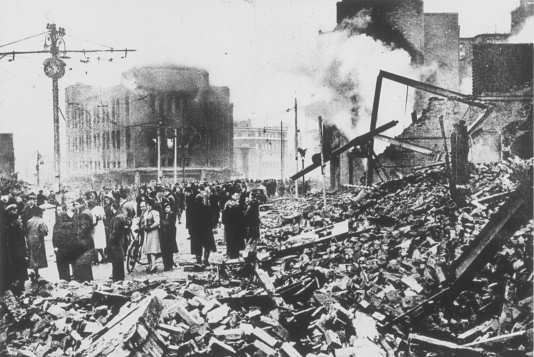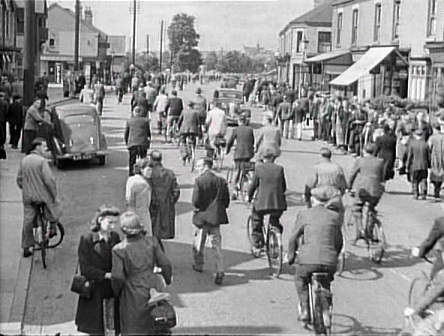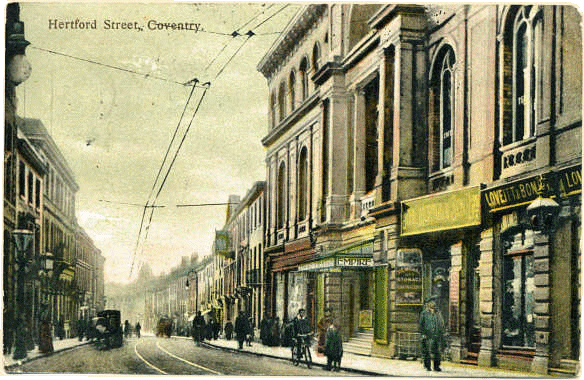|
Index...
|
 was born in a small terrace house at 273 Alderman's Green Rd, Coventry at about 12 noon on a very hot day on the 22nd June 1932. My Father was William James Hill Born 17th Dec 1907.
was born in a small terrace house at 273 Alderman's Green Rd, Coventry at about 12 noon on a very hot day on the 22nd June 1932. My Father was William James Hill Born 17th Dec 1907.
Dad was employed as a milling machinist at the Motor Rim and Wheel works in Coventry at the time of my birth. Soon after the memorable occasion of my birth, however, Dad was out of work as a result of the biggest depression that the world had ever known. He told me that he used to walk along the railway embankments and pick up pieces of coal that had fallen from the steam trains. This was illegal of course, but lots of people did this and the railway authorities turn a blind eye to the practice during those very hard times. Coventry was a highly industrialised city, and was adequately served by a good railway system in those days.
As a result of the breakup of my parent's marriage we were shunted around, living in London, Luton, and finally back to Coventry. My sister and I were living with my mother in Coventry in a road called Glaisdale Avenue, Holbrooks when the blitz started. We attended a school called Whitemoor, and I would have been about eight years old. Mother made friends with a woman who worked at the Dunlop factory, and as a result of this friendship Mum was able to get a job at the Dunlop factory and subsequently a rented house close by.
 Bewildered people gather around what was once their prime shopping street, Broadgate, the day after the big raid of 14th November 1940.
Bewildered people gather around what was once their prime shopping street, Broadgate, the day after the big raid of 14th November 1940.
Coventry's biggest raid was carried out on the night of November 14th 1940. The German High Command apparently said that they had rained 30,000 fire bombs and five hundred tons of high explosives and baskets of fragmentation bombs on the city. These baskets of bombs, or "Land Mines" as they were called, were dropped over a wide area. They killed lots of people and did a tremendous amount of damage. The Dunlop factory was heavily damaged during this raid with a heavy loss of life but my Mother was OK. During this raid the beautiful Coventry Cathedral, built in the fourteenth century, was burned to the ground, and only the tower and steeple remained.
After the war had ended the Church Authorities started to rebuild the New Cathedral, and the nails and melted metal from the ruined cathedral was made into a cross of remembrance and placed in the new cathedral that was built much later. My mother told me that she had donated a certain amount of money to the rebuilding fund, and my name was put on the roll of honour. She told me that I was christened at the Coventry Cathedral, so this was a nice bit of memorabilia to add to my memoirs.
It was during this raid that our house was bombed and all the windows and half the roof was blown off. Later, after things had settled down again, my sister and I would go and play in the ruins of the bombed buildings, making cubby houses out of the debris and digging holes in the ground. A lot of these holes used to get filled with water when it rained and we would end up getting filthy dirty and get told off when we got home. It was never in our mind to take things from the bombed buildings even though we had plenty of opportunity to do so. I never once saw anyone looting in those days though; I do not think that we even knew what looting meant.
 People leaving work at the end of a busy shift. In this case they're finishing at the Humber Works, Humber Road.
People leaving work at the end of a busy shift. In this case they're finishing at the Humber Works, Humber Road.
My mother was very busy at her job at the Dunlop factory in Coventry, working long hours from seven am, getting home about eight at night, travelling to and from work on the local train. The railways took a battering during the raids but were very quickly restored to working order. The Dunlop factory was producing aircraft and bombs, and as a consequence was bombed on several occasions quite severely, but kept working despite all of this. During the raid the houses at the top of the road were bombed and a parachute with a basket of bombs (called land mines) got lodged in the chimney pots. They did not explode, so everyone had to move out in case they dislodged them, and could only move back when they had been de-activated.
In those days everyone had to tape over their windows with thick brown paper to stop the glass from flying about in a bomb blast. They had to have them covered in any case as they were compelled to have complete blackout at night. No one was allowed to show any light at all because this helped the German night bombers find their way to the targets. It was quite difficult sometimes to try and remember to cover every little window or crack in the doors. We were soon told though when the ARP man came round the district checking up on every one.
During the black-out it was very difficult to move around at night, so the councils painted kerbs, lamp posts and gutters white. This made it a bit easier to move around but we didn't go out much at night anyway. Apparently the accident rate tripled after these conditions were enforced, and not only traffic accidents. People were also injured by just walking into lampposts and street corners.
 here were about a thousand people killed the night of the raid, and a tremendous amount of damage done around the city. The Germans said that this raid was a reprisal for the R.A.F. attack on Munich a few days previously. The newspapers said that two German Aircraft were shot down, not very many but I suppose better than none at all. We did not have many aircraft to fight back so early in the war as they were committed in other areas at this time; consequently the Germans had it pretty much their own way for a long time.
here were about a thousand people killed the night of the raid, and a tremendous amount of damage done around the city. The Germans said that this raid was a reprisal for the R.A.F. attack on Munich a few days previously. The newspapers said that two German Aircraft were shot down, not very many but I suppose better than none at all. We did not have many aircraft to fight back so early in the war as they were committed in other areas at this time; consequently the Germans had it pretty much their own way for a long time.
To assist the Air Raid Wardens to do their jobs there were buckets of sand placed at strategic positions everywhere, so that you could cover the incendiary bombs with the dry sand. There were also buckets of water and stirrup pumps provided at various places too. The local authorities in Coventry had also built municipal air raid shelters in the streets, but these were next to useless as there was not enough cement put into the aggregate to bind the mix together, consequently they were always in a state of disrepair.
My sister and I used to stand in the street watching the action taking place in the skies, but we were told off by the air raid wardens "ARP" (Air Raid Precautions) and were sent inside to take shelter under the stairs. This was supposed to be the safest place in the house, and in fact saved a lot of lives when most of the buildings were destroyed and only the stairs were left standing. From time to time my sister Pat and I would go and collect beer bottles and get two pence each for them. Twopence was a lot of money for bottles in those days but I suppose any mineral was valuable in times of war. That was one of the main reasons that we got so much for our bottles I suppose, but we did not argue about the price we got. Two pence was the entrance fee for Saturday morning cinema shows.

These were known as the twopenny rush in those days and they would show a serial which would end when the hero was in some desperate situation and this would entice you to go the following week. These films were made with the hero "Buck Rogers" in a space ship very similar to our present ones. From time to time during that part of the war the cinemas would be shut down for a while, the reason being that too many people would be congregated together. The local authorities said that the closure of the cinemas was to protect the people in case of bombing. They did re-open soon after though as it was considered more of a morale booster and was apparently worth the risk.
The German Bombers, mainly "Heinkels and Dornier's", flew in and used to follow the canals which would shine with the light of the moon on the surface of the water. This made it an easy job to plot the whereabouts of an important factory which had a canal right to its front door. These canals were made to make the transport of goods cheaper and easier to move, but obviously were very dangerous when the enemy wanted to bomb that particular factory or area. To counteract this problem the local authorities used to drop soot on the water to stop the canals shining on a moonlight night. This method sometimes worked OK, but was dependent on the weather being rain-less and with no wind. If it rained of course the soot was easily washed away and so was only a temporary solution to the problem.
Coventry had lots of groups of barrage balloons placed around strategic areas. This method turned out to be quite successful though, and prevented the dive bombers from getting in too low and strafing their targets.
 A German bomber brought down by a barrage balloon.
A German bomber brought down by a barrage balloon.
My mother was very worried and frightened as a result of the continual bombing and tremendous damage meted out to Coventry whilst we were living there. This was not surprising I suppose for a woman living on her own with the responsibilities of a small family. So after living in this stressful state during the bombing in Coventry, my Mother wrote to Dad who was living in Luton. She told him of the dangerous situation that we were all being exposed to and asked him if we could go back to live with him.
Luton was also getting heavy air raids as a result of its industries, but obviously not on the same scale as Coventry. Dad agreed to Mam's request, and as a result of this we soon were soon moved back to Luton. I have not been back to Coventry since the bombing but have read quite a lot about it since those early days.
Website by Rob Orland © 2002 to 2025